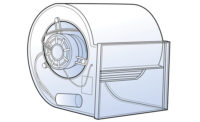In HVAC installations, the largest share of energy consumption can be attributed to equipment such as chillers and boilers. However, fans also have a significant energy footprint, especially those in air handlers and cooling towers. In the case of hydronic HVAC systems, pumps also demand plenty of electric power
The efficiency of fans and pumps can be improved in two steps: first, equip them with high-efficiency motors of adequate capacity. Then speed controls can be added for further efficiency gains.
Even if an HVAC installation uses chillers and boilers with the highest efficiency in the market, the overall system performance will not be optimal if fans and pumps are operating inefficiently.
Purchasing upgrade motors - Rated capacity & efficiency
According to the International Energy Agency, electric motors account for 45 percent of global electricity consumption. For this reason, energy efficiency measures that target motors can yield significant savings. This is especially true for motors with extended operating schedules, like those found in HVAC installations.
NEMA Premium is the highest motor efficiency rating under North American standards, and the highest efficiency class under IEC standards is IE4 (Super Premium Efficiency). While the NEMA Premium rating covers motors from 1 to 500 hp, the IE4 Super Premium rating covers motors from 0.12 to 1000 kW. NEMA Premium is roughly equivalent to the previous IE3 Premium Efficiency rating under IEC standards.
Many existing motors are slightly oversized for their application; NEMA has determined that HVAC fan motors typically run at 70-75 percent of their rated capacity. Contrary to popular belief, this does not cause a drastic loss of efficiency. If the motor is upgraded to a more efficient unit, downsizing may be difficult due to the frame size change, causing additional expenses without a significant efficiency improvement.
Oversizing is not an issue if the motor operates at around 70 percent capacity, but efficiency starts to drop significantly around 50 percent load. A drastically oversized motor is also much more expensive while operating at a low power factor. On the other hand, undersized motors should always be avoided: they overheat, their service life is reduced, and they are susceptible to sudden failure.
Improving efficiency with HVAC motor controls
The operating cost of HVAC fans and hydronic pumps is reduced significantly once they are equipped with high-efficiency motors, but superior efficiency is possible by controlling motor speed according to demand.
The benefits of variable frequency drives (VFD) are well known in the HVAC industry, especially when they are used to adjust fan speed according to load. For instance, if a cooling tower fan operates for 10 percent less time, it uses 10 percent less electricity on average. On the other hand, a 10 percent speed reduction yields theoretical savings of 27 percent. Speed control with VFDs is a viable measure, as long as their harmonic distortion is kept under control with adequate filters.
Brushless DC motors, also known as electronically commutated motors (ECM), are a viable option for applications below 1 hp. In addition to being highly efficient, they have built-in speed control and don’t rely on an external device.
Once the motor speed control system is in place, the next step is defining the control algorithm. Demand-controlled ventilation (DCV) is a common approach, where fan speed is adjusted according to building occupancy. However, an emerging concept is making DCV responsive to air pollution as well:
- High occupancy correlates with more air pollution, but there are cases where air pollution may be high even with low occupancy.
- For example, new furniture and construction materials release large amounts of volatile organic compounds (VOC) through off-gassing, and many cleaning products are notorious for their high VOC content.
In the case of hydronic HVAC systems, reduced airflow also decreases the cooling and heating that must be provided by air handler coils. Pump motors can also be equipped with VFDs, achieving variable flow without control valves and their associated hydraulic losses.
If an HVAC design uses high-efficiency chillers and boilers, speed control can be used to find the system operating point with the lowest cost. For example, pumps can be ramped down to reduce water flow through hydronic piping, while a chiller is ramped up to deliver cooler water and keep the same cooling output. If the extra chiller power is less than the pumping savings, the system operating cost is decreased while serving the same cooling load.
Michael Tobias is the founder and principal of Chicago Engineers, an Inc 5000 Fastest Growing Company in America. He leads a team of 30-plus mechanical, electrical, plumbing, and fire protection engineers from the company headquarters in New York City. This article originally appeared in the May 2019 issue of SNIPS Magazine.










